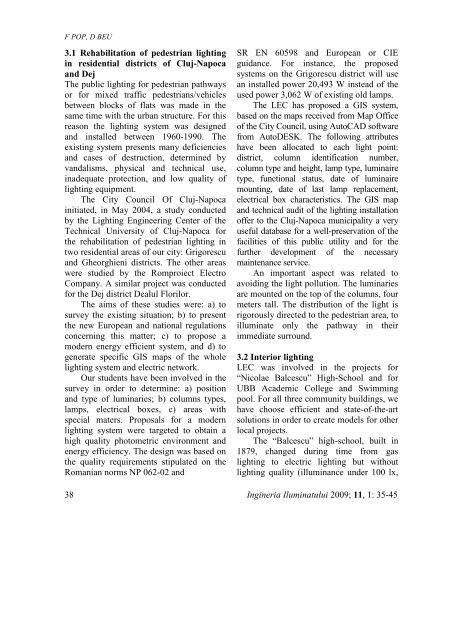ingineria iluminatului - Journal of Lighting Engineering - Prof. Florin ...
ingineria iluminatului - Journal of Lighting Engineering - Prof. Florin ...
ingineria iluminatului - Journal of Lighting Engineering - Prof. Florin ...
Create successful ePaper yourself
Turn your PDF publications into a flip-book with our unique Google optimized e-Paper software.
F POP, D BEU<br />
3.1 Rehabilitation <strong>of</strong> pedestrian lighting<br />
in residential districts <strong>of</strong> Cluj-Napoca<br />
and Dej<br />
The public lighting for pedestrian pathways<br />
or for mixed traffic pedestrians/vehicles<br />
between blocks <strong>of</strong> flats was made in the<br />
same time with the urban structure. For this<br />
reason the lighting system was designed<br />
and installed between 1960-1990. The<br />
existing system presents many deficiencies<br />
and cases <strong>of</strong> destruction, determined by<br />
vandalisms, physical and technical use,<br />
inadequate protection, and low quality <strong>of</strong><br />
lighting equipment.<br />
The City Council Of Cluj-Napoca<br />
initiated, in May 2004, a study conducted<br />
by the <strong>Lighting</strong> <strong>Engineering</strong> Center <strong>of</strong> the<br />
Technical University <strong>of</strong> Cluj-Napoca for<br />
the rehabilitation <strong>of</strong> pedestrian lighting in<br />
two residential areas <strong>of</strong> our city: Grigorescu<br />
and Gheorghieni districts. The other areas<br />
were studied by the Romproiect Electro<br />
Company. A similar project was conducted<br />
for the Dej district Dealul Florilor.<br />
The aims <strong>of</strong> these studies were: a) to<br />
survey the existing situation; b) to present<br />
the new European and national regulations<br />
concerning this matter; c) to propose a<br />
modern energy efficient system, and d) to<br />
generate specific GIS maps <strong>of</strong> the whole<br />
lighting system and electric network.<br />
Our students have been involved in the<br />
survey in order to determine: a) position<br />
and type <strong>of</strong> luminaries; b) columns types,<br />
lamps, electrical boxes, c) areas with<br />
special maters. Proposals for a modern<br />
lighting system were targeted to obtain a<br />
high quality photometric environment and<br />
energy efficiency. The design was based on<br />
the quality requirements stipulated on the<br />
Romanian norms NP 062-02 and<br />
SR EN 60598 and European or CIE<br />
guidance. For instance, the proposed<br />
systems on the Grigorescu district will use<br />
an installed power 20,493 W instead <strong>of</strong> the<br />
used power 3,062 W <strong>of</strong> existing old lamps.<br />
The LEC has proposed a GIS system,<br />
based on the maps received from Map Office<br />
<strong>of</strong> the City Council, using AutoCAD s<strong>of</strong>tware<br />
from AutoDESK. The following attributes<br />
have been allocated to each light point:<br />
district, column identification number,<br />
column type and height, lamp type, luminaire<br />
type, functional status, date <strong>of</strong> luminaire<br />
mounting, date <strong>of</strong> last lamp replacement,<br />
electrical box characteristics. The GIS map<br />
and technical audit <strong>of</strong> the lighting installation<br />
<strong>of</strong>fer to the Cluj-Napoca municipality a very<br />
useful database for a well-preservation <strong>of</strong> the<br />
facilities <strong>of</strong> this public utility and for the<br />
further development <strong>of</strong> the necessary<br />
maintenance service.<br />
An important aspect was related to<br />
avoiding the light pollution. The luminaries<br />
are mounted on the top <strong>of</strong> the columns, four<br />
meters tall. The distribution <strong>of</strong> the light is<br />
rigorously directed to the pedestrian area, to<br />
illuminate only the pathway in their<br />
immediate surround.<br />
3.2 Interior lighting<br />
LEC was involved in the projects for<br />
“Nicolae Balcescu” High-School and for<br />
UBB Academic College and Swimming<br />
pool. For all three community buildings, we<br />
have choose efficient and state-<strong>of</strong>-the-art<br />
solutions in order to create models for other<br />
local projects.<br />
The “Balcescu” high-school, built in<br />
1879, changed during time from gas<br />
lighting to electric lighting but without<br />
lighting quality (illuminance under 100 lx,<br />
38 Ingineria Iluminatului 2009; 11, 1: 35-45
















